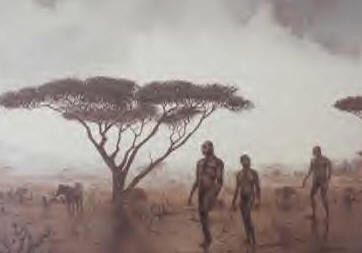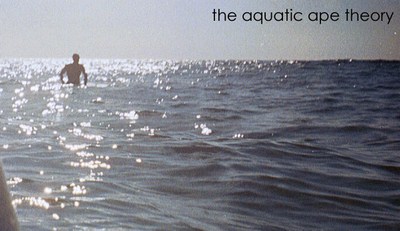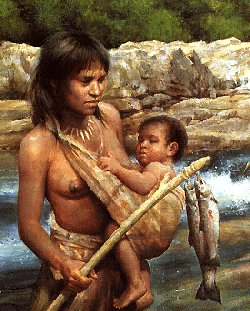- Articles Index
- Monthly Features
- General History Articles
- Ancient Near East
- Classical Europe and Mediterranean
- East Asia
- Steppes & Central Asia
- South and SE Asia
- Medieval Europe
- Medieval Iran & Islamic Middle East
- African History (-1750)
- Pre-Columbian Americas
- Early Modern Era
- 19'th Century (1789-1914)
- 20'th Century
- 21'st Century
- Total Quiz Archive
- Access Account
Killer Ape/Cuddly Ape
Category: General History Articles
By Paul
|
Savannah Theory
|
Savannah Theory argued the forests of South Africa began to shrink and the primate ancestors of man ventured out onto the hot, flat, African Savannah. There they were forced to stand bipedally to avoid predators and hunt, freeing their hands to develop into intricate tool manufacturing devices and growing a brain to plan even more complex hunting strategy and weapon designs.
By the 1960’s a theory thought up by Dart was accepted as orthodoxy became the theory taught in all schools worldwide, so strong was it that it became scientific heresy to oppose it.
What became known of as Savannah Hypothesis was written on and expanded by many authors, the most famous Desmond Morris in the Naked Ape. Where human ancestors struck out from the forest and threw themselves into competition with the ground birds. Pressure to increase their hunting capabilities caused them to become faster runners, walk upright so their hands became free to hold weapons and tools, their brains grew making brighter quicker decision makers. “A hunting Ape, a killer ape”.
The Killer Ape
|
In the wake of wwii and the midst of the Vietnam War a Killer Ape Theory found a ready audience, explaining man’s murderous instincts, war and attributing an urge to do violence a fundamental part of his evolutionary psyche. It was a very macho theory, the male apes went out hunting for red meat whilst the females stayed home doing little but tend for the young and being thrown the odd scrap off the table when the hunters had finished eating.
A simplistic but bloody account, throughout the 80’s and 90’s it became apparent Savannah theory was over simplified.
Work on the Taung area where the skull was found, showed hundreds of thousands of years ago it wasn’t as dry as it is now and probably wasn’t Savannah after all.
Also no other species in evolutionary history has voluntarily changed it’s environment, evolution doesn't work like that, so how could man’s ancestors voluntarily venture onto the Savannah.
And finally the simple ill-suitedness which man is to life on a Savannah. If man had evolved on a Savannah we would be much more adapted than we are.
Over many years these and many more niggling little objections had built up. However in 1995 a bombshell struck the theory. Professor Philip Tobias a former student of Dart had spent decades in the chalk beds where Dart found the Taung Child trying to fill in the gaps in theory was beginning to have doubts about Dart’s theory along with many other leading Paleo-Anthropologists.
In 1995 Tobias declared at a large conference “The Savannah Hypothesis is no more” after it emerged in sites in south and east Africa that some early hominids dwelling in forest became bipedal without ever venturing onto a savannah. Effectively this eliminated Savannah as a cause of bipedalism effectively destroying the whole Savannah Theory of evolution.
Alternative Theories
As the Savannah hypothesis became discredited Palaeontologists began to look around for another theory to explain the early evolution of man without much luck. It was also remembered there was already one that had been around for more than 30 years that had been conveniently sidelined while Savannah Theory reigned unchallenged. The theory often named Aquatic Ape Theory.
In a late 60’s an award winning Welsh playwright and journalist Elaine Morgan read Desmond Morris’s Naked Ape. She noted the theory put all evolution in terms of what was advantageous for the male. And many things disadvantageous to the females, who were left simply sitting around all day doing nothing begging scraps of meat from the male. She regarded female role in the theory was both preposterous and no species could evolve on these terms of it being advantageous to a single sex and disadvantageous for the other.
Morgan also noted a single passage in Morris’ Naked Ape which stated an alternative theory that before the Ape had emerged on the Savannah it had spent sometime as an Aquatic Ape living beside water. This theory had been put forward by an Oxford Marine Biologist Sir Alistair Hardy in The New Scientist in 1960. He had originally thought of the theory in the 1930's but had been warned against publishing because he would destroy his career through heresy.
Hardy had become interested in the peculiar layer of fat tightly bonded to the skin, that humans have but other primates don’t. Such layers of fat are only found in water mammals. So Hardy thought man might have been more aquatic in the past. In his article he went on to suggest a shore based environment might also explain man becoming bipedal too.
A Wader Ape
|
A branch of primates was forced from the forest by competition moved to the sea shore to search for food, shell fish and urchins in the shallow waters of the coast. Initially paddling in shallow waters gradually he evolved the ability to venture into deeper waters, standing on the bottom with his head out the water and the water supporting his weight he learnt to become bipedal in the water.
Elaine Morgan sought permission from Alistair Hardy to write a book on his theory and in 1972 she published, The Descent of Women, and what would become known as Aquatic Ape Theory.
Immediately the book cause a storm amongst the paleontological world. She was branded a crank and amongst her leading hecklers at lectures were Richard Dawkins and Douglas Adams.
Elaine Morgan sought permission from Alistair Hardy to write a book on his theory and in 1972 she published, The Descent of Women, and what would become known as Aquatic Ape Theory.
Immediately the book cause a storm amongst the paleontological world. She was branded a crank and amongst her leading hecklers at lectures were Richard Dawkins and Douglas Adams.
|
In Aquatic Ape Hypothesis man was far from a killer ape and women’s role far from that of a passive breeder. Both males and females, instead, jointly harvested the sea, walking along the shoreline gathering shellfish. Society was not one of alpha males and hierachies of violence and domination but an effort of communal gathering.
However Aquatic Ape Theory was much more than this, it provided something Savannah Theory never could, a comprehensive explanation for all of the characteristics that distinguish us from the other apes. Bipedal, hairlessness, layer fat below the skin, big brain, language skills, large noses but weak sense of smell, ability to sweat, swimming diving, fat babies.
The Brain
The maxim of Savannah Theory that humans developed large brains because of hunting competition with other predators on the savannahs of Africa has no parallels. Every other species that ventured onto the Savannahs reduced its brain size.
Professor Michael Crawford of the Institute of Brain Chemistry and Human Nutrition in London, in a study into to why there are different sizes of brains in different animals established that the brains of all Savannah animals had shrunk as they grew larger bodies. He also found that in order for a brain to grow it needs a supply of Omega 3, especially VHA and Iodine and the only place to find these nutrient through a marine food chain.
This is a testable theory, the theory argues marine nutrients in the human diet are essential to growth of the human brain, then a change of diet away from these nutrients would surely be detrimental to it.
According to the World Health Organisation report in 2004, Iodine deficiency among inland populations effects around 740 million people worldwide. EG: 60% of school children in Korea are Iodine deficient and 60% of children in Indonesia have thyroid gland goitre but in fishing villages not a single one.
Another important ingredient to brain growth is the body fat only found on man and marine mammals. A Chimp's brain is almost as big as a human baby’s brain at birth. However a human baby has a 10 fold increase in fat in the last 10 weeks of pregnancy making 30% of the baby’s total weight brain and body fat. Baby Chimps and Gorillas have no body fat at all. The human brain trebles in size from birth to the age 10, Chimps brains don’t. Human body fat provides the fuel for the growth of the human brain.
Of all man’s ancestors, Home Erectus, experienced the largest singe brain growth. Most Homo Erectus finds have been found along coastal areas and Erectus is accepted by mainstream archaeology to be a shore dweller.
Professor Michael Crawford of the Institute of Brain Chemistry and Human Nutrition in London, in a study into to why there are different sizes of brains in different animals established that the brains of all Savannah animals had shrunk as they grew larger bodies. He also found that in order for a brain to grow it needs a supply of Omega 3, especially VHA and Iodine and the only place to find these nutrient through a marine food chain.
This is a testable theory, the theory argues marine nutrients in the human diet are essential to growth of the human brain, then a change of diet away from these nutrients would surely be detrimental to it.
According to the World Health Organisation report in 2004, Iodine deficiency among inland populations effects around 740 million people worldwide. EG: 60% of school children in Korea are Iodine deficient and 60% of children in Indonesia have thyroid gland goitre but in fishing villages not a single one.
Another important ingredient to brain growth is the body fat only found on man and marine mammals. A Chimp's brain is almost as big as a human baby’s brain at birth. However a human baby has a 10 fold increase in fat in the last 10 weeks of pregnancy making 30% of the baby’s total weight brain and body fat. Baby Chimps and Gorillas have no body fat at all. The human brain trebles in size from birth to the age 10, Chimps brains don’t. Human body fat provides the fuel for the growth of the human brain.
Of all man’s ancestors, Home Erectus, experienced the largest singe brain growth. Most Homo Erectus finds have been found along coastal areas and Erectus is accepted by mainstream archaeology to be a shore dweller.
Breath Control
There are 3 kinds of breathing pattern in mammals, voluntary, involuntary and both.
Involuntary breathing is how humans breath most of the time, it requires no thought to do and is done unconsciously. Voluntary breathing is when thoughts takes over from the unconscious process. Voluntary breathing is used when we hold our breath, play a wind instrument or practice deep breathing exercises.
All primates and land mammals are involuntary breathers only. None have the capability to hold their breath.
Sea mammals such as dolphins and whales are conscious breathers which is why only half their brains can ever go to sleep at one time, otherwise they forget to breath and drown
A small third groups exist which can both consciously and unconsciously breath, these are amphibious mammals, such as seals and otters, who can hold their breath, dive underwater for food and return to the shore revert back to unconscious breathing. Humans are the only primates with this capacity.
Breath control then goes a stage further. During human speech conscious is needed, people in a conversation freely switch back and forth between conscious and unconscious breathing, many of the noises needing conscious breath control to make. This breath control then may be what allows us to develop speech while other primates, having the intelligence for communication have failed to do so.
Birth
Amongst native people’s living in coastal regions it was traditional for women to go into the sea to give birth. This only ceased when the missionaries thought it wrong and made them stop.
One of the main fears about babies being born under water is that they will drown, but they don’t, this is because of what's called the diving reflex. The human diving reflex, that if water is on the face, the throat closes off, is strongest in new born babies. Babies are very at home in the water and amongst coastal people swimming is so natural it is common for children to learn to swim and dive under water before they can walk.
Professor Peter Wheeler, Dean of Science at Liverpool St John Moore’s University is the leading opponent of the Aquatic Ape theory. He believes giving birth in water cannot be an evolutionary adaptation because “Human babies lose heat very easy”. However in Russia it is quite common for women to give birth in the Black Sea at 19-20 degree temperatures.
One more thing about human birth little studied is, Vernix Caseosa, Latin for ‘cheesy varnish’ and the name of the white fatty/greasy coating on the skin of a human baby when it is born. One theory is that it protects the baby’s skin while it is submerged in amniotic fluid. If so surely all mammal babies would have it, but they don’t, not even any other primates, in fact the only other mammal that has it is seals. Harbour seals are born on land but enter the water 30 minutes or so after birth, have a coating of Vernix Caseosa, though somewhat thinner than human babies. Grey seals who enter several hours after birth are born with an even thinner coat and hooded seals that don’t enter the water for over a day have an almost undetectable coating.
The Beginning
Aquatic ape Hypothesis is far from proven, but at the moment enjoys the luxury of being the only theory of human evolution in existence at present. most of the scientific research being done in the area is on Aquatic Ape Hypothesis and its days as a crank theory in the distant past. A new generation of ethno-paleontologists exist and the killer ape a lot more cuddly than before.
http://www.bbc.co.uk/radio4/science/scarsofevolution.shtml
Source
http://www.bbc.co.uk/radio4/science/scarsofevolution.shtml





